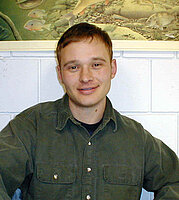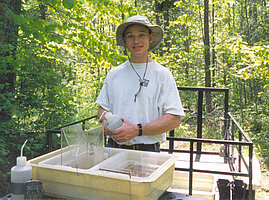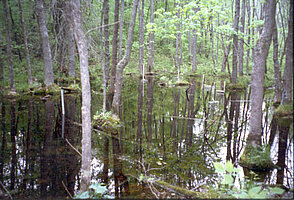Characteristics and Influences of Upland Tree Harvest in Northern Forested Wetlands: Baseline Studies of Wetland Invertebrate Communities

Anthony Miller's hometown is Benton, KY. He received a BS from Murray State University in 1997 with an emphasis in fisheries and aquatics. Tony expects to complete his master’s degree in the fall of 2001. His career objective is to work in aquatics research and to eventually get his PhD in a related field.
Fellow: Anthony T. Miller , Department of Zoology, NDSU
Advisor: Malcolm Butler, Professor of Zoology, NDSU
Matching Support: Minnesota Department of Natural Resources, St. Paul, MN
Collaboration: U.S. Forest Service
Degree Progress: M.S. completion anticipated in 2001
Characteristics and Influences of Upland Tree Harvest in Northern Forested Wetlands: Baseline Studies of Wetland Invertebrate Communities
Seasonally-flooded wetlands are common throughout forested regions of North America, and invertebrate assemblages in these ecosystems are poorly known. Functional links to adjacent uplands appear to be strong, thus land-use practices such as silvaculture may influence the physical structure and processes in these wetlands. For example, it is widely believed that timber harvest modifies natural wetland hydroperiods through influences on local evapotranspiration rates.
Current research in the Butler group is part of a longer-term collaboration between the U.S. Forest Service (USFS), Minnesota Department of Natural Resources (MNDNR) and North Dakota State University (NDSU), which has two main objectives. First, natural variation of the aquatic invertebrate communities will be assessed in 16 seasonally flooded wetlands in old-growth (70+ years since harvest) aspen stands in north central Minnesota. Also, the factors influencing this variation will be elucidated. Secondly, after natural variation is assessed, the wetlands will be subjected to experimental timber harvest techniques and invertebrate responses will be measured.
Invertebrates are being collected in activity traps several times during the season and are being compared to environmental variables using multivariate techniques. Redundancy analysis of preliminary data collected prior to timber harvest has indicated that hydroperiod has a strong influence on the invertebrate communities in our wetlands. Light limitation appears to have a secondary role in shaping the community, probably through its effects on the growth of phytoplankton and epiphyton that serve as important food sources for many herbivorous invertebrates.
Our results are expected to indicate that abiotic processes play key roles in configuring invertebrate communities in seasonally flooded, forested wetlands. It is suggested that timber harvest or other disturbances in adjacent uplands may have unexpected implications for biotic communities in forested wetlands. The results of this study will be used to create ecologically sound management guidelines for tree harvest adjacent to forested wetlands on land managed by the U.S. Forest Service.
This MS thesis focuses on the initial objective of characterizing wetland invertebrate communities prior to timber harvest, and will extend through the second (2001) field season. The USFS and MNDNR, and potentially NDSU, will continue the research for an two additional years.



Melcolm Butler
Biological Sciences
Office: Research 2, Room 214B
Phone: 701-231-7398
Email: malcolm.butler@ndsu.edu


